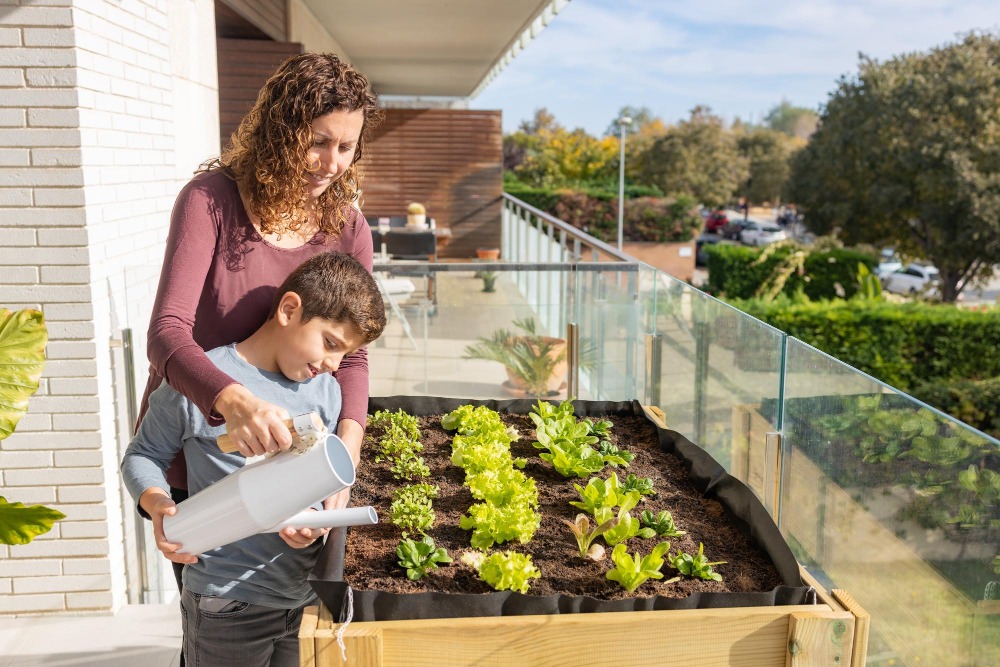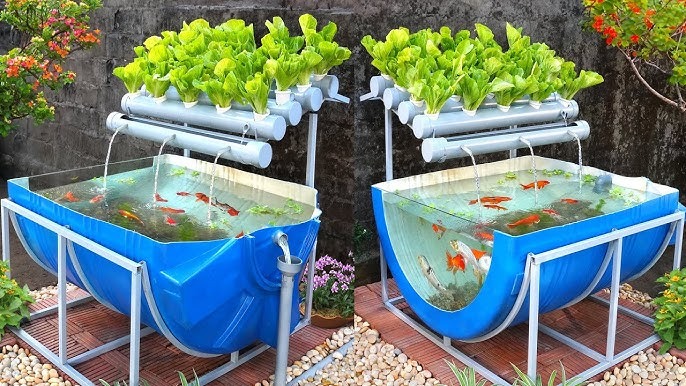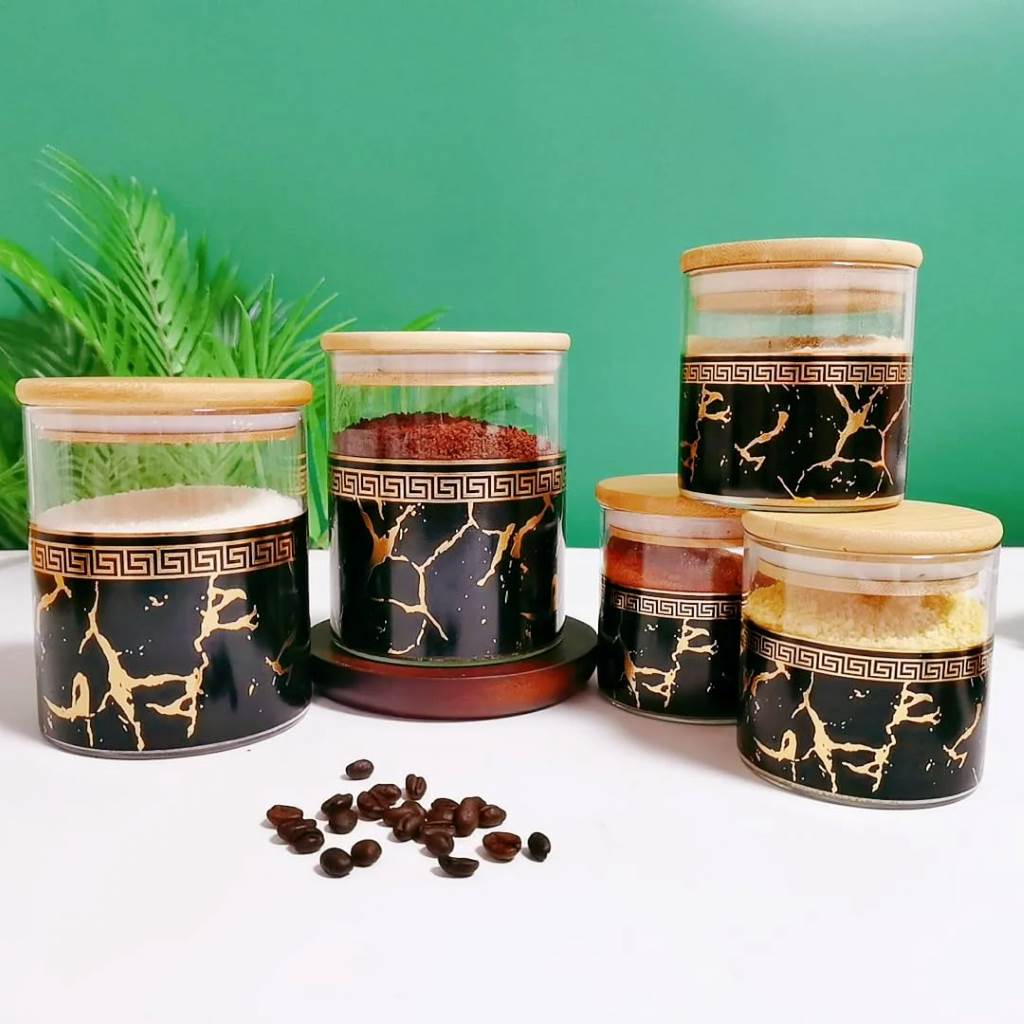Picture this: You step onto your tiny balcony after a long day in the city grind. The sun dips low, casting a warm glow over a lush setup of vibrant greens swaying gently and a quiet tank humming with life. You pluck a handful of crisp lettuce, and dinner feels worlds away from the grocery store rush. That’s the magic of an aquaponics system for a small balcony. It blends fish farming with soilless plant growth in a closed loop. Fish waste feeds the plants. Plants clean the water for the fish. No soil. No endless weeding. Just fresh food from a spot no bigger than a card table.
This setup shines in urban spots where space screams premium. You grow herbs, veggies, and even small fish right outside your door. It fits balconies, patios, or sunny corners without hogging room. Recent stats paint a clear picture. The USDA reports over 71 aquaponics farms across 21 U.S. states in 2012, with many small-scale ones thriving in cities today. A 2023 MDPI study shows aquaponics cuts water use by up to 90% compared to traditional gardening. Plus, the global aquaponics market hits $1.42 billion in 2025, per Mordor Intelligence, driven by urban demand for local, sustainable eats. Ready to claim your slice of this green revolution? Let’s dive in.
What Is an Aquaponics System?
An aquaponics system merges two worlds: aquaculture and hydroponics. Aquaculture raises fish in tanks. Hydroponics grows plants in nutrient-rich water, skipping soil altogether. Together, they create a symbiotic dance. Fish produce waste loaded with ammonia. Beneficial bacteria turn that into nitrates—plant food. Plants soak up those nitrates, filtering the water back to crystal clear for the fish.
Think of it as nature’s recycling plant, shrunk to balcony size. Water cycles endlessly, with minimal top-offs. No chemical fertilizers. No pesticides. Just balance. For small spaces, this means a compact tank under a grow bed or vertical towers that stack up like living shelves. A basic loop needs a fish tank, pump, grow media like clay pebbles, and pipes to shuttle water. Bacteria colonize the media, kickstarting the magic.
Why does this matter for city folks? Urban soil often hides toxins. Balconies dodge that hassle. You control everything—from light to feed—in a footprint under 4 square feet. A ResearchGate study from 2021 highlights how balcony aquaponics fed families during lockdowns, proving its grit in tight quarters. It’s not just gardening. It’s a mini-ecosystem that boosts your plate and your peace.
Benefits of a Balcony Aquaponics Setup
City life squeezes us. Balconies offer escape, but dirt gardens? Forget it. Enter aquaponics: a smart fix that packs punch without sprawl. You harvest daily, slash bills, and tread lighter on the planet. Let’s break it down.
First, space smarts rule. Traditional plots gobble ground. Aquaponics stacks vertical or tucks horizontal. A 3×5-foot setup yields enough greens for two people weekly, says Engineering for Change. No digging. No sprawl.
Water wisdom follows. Soil farming guzzles 70% of global fresh water, per UN stats. Aquaponics recycles 90-95% of it. Evaporation? Barely. Runoff? None. In drought-hit spots like California, this saves thousands of gallons yearly.
Food freshness fuels health. Pick basil mid-meal. No trucking emissions. A 2023 Frontiers for Young Minds piece notes aquaponics cuts transport footprints by 80%, delivering nutrient-dense eats straight to fork.
Sustainability seals the deal. Zero waste loops cut landfill trash. Fish thrive organically. Plants flourish chemical-free. The Oklahoma State Extension pegs small systems at 75% of U.S. aquaponics ops under low output, yet they build resilience. Plus, it’s fun—watch fish dart as leaves unfurl.
Mental perks? Gardening eases stress. A balcony oasis invites birds, butterflies. Kids learn science hands-on. In short, this system turns concrete into bounty, one cycle at a time.
Aquaponics vs. Hydroponics: Which Wins for Small Spaces?
You hear hydroponics buzz too. Both ditch soil for water-based growth. But aquaponics adds fish flair. Hydro skips the tank, pumps in synthetic nutrients. Aquaponics lets fish supply them naturally. Which fits your balcony better?
Hydroponics shines in speed. Plants bolt faster without fish balance checks. Setup? Simpler, smaller footprint. Trees.com notes hydro fits micro-spaces like apartment nooks. Yields soar—up to 30% more greens. But you buy fertilizers. pH swings demand tweaks. Waste? It drains out.
Aquaponics counters with wholeness. Fish waste mimics soil, building robust roots. No chem buys. Water stays cleaner longer. A 2022 Trees.com comparison shows aquaponics edges hydro in eco-scores: 90% less water, zero synthetics. Downside? Fish care adds steps. Balance tilts if one side lags.
For balconies, aquaponics wins heart. It adds protein punch—edible fish like tilapia. Hydro suits pure veggie chasers. Space-wise, both compact. But aquaponics’ loop feels alive, forgiving newbie slips with bacteria buffers. Per Go Green Aquaponics, hybrid fans grow diverse—herbs below, fish below. Pick based on vibe: quick crops or full ecosystem?
Choosing the Right Design for Your Balcony
Balconies vary—sunny south-facing or shady north? Windy high-rise or sheltered low? Match design to yours. Start small: 20-gallon tank base. Scale as confidence grows.
Media bed systems top lists for beginners. Gravel or clay holds roots, hosts bacteria. Stack tank below bed. Pump water up, let it flood-drain. Insteading.com praises this for stability in breezy spots.
Vertical towers dazzle space-hogs. PVC pipes stack like totem poles. Water trickles down, feeding plants en route. Go Green Aquaponics touts 10x yield in half footprint. Ideal for herbs climbing rails.
Raft floats? Styrofoam trays bob in shallow channels. Roots dangle free. Best for leafy greens craving calm flow. But watch wind—secure against gusts.
NFT channels? Thin films rush nutrients. Slim, wall-mountable. Suits tomatoes trailing down. Yet clogs nip at heels.
Assess light first. Six hours sun? Go raft. Shade? LED-boost media. Weight matters—tanks tip scales. Use sturdy stands. A 2024 ResearchGate vertical design for apartments weighs under 100 pounds full.
Pro tip: Sketch it. Measure twice. Local codes? Check rail loads. Your balcony blooms unique—design honors that.
Step-by-Step Guide to Building Your DIY Aquaponics System
Roll up sleeves. Building thrills as much as harvesting. This guide crafts a basic media bed setup for a 4×4-foot balcony. Tools: drill, saw, level. Time: weekend warrior pace. Follow along.
Step 1: Gather Materials
Stock up smart. Core kit: 20-gallon plastic tank for fish. 2×4-foot grow bed frame from lumber. Pond liner seals it. Clay pebbles fill bed—light, bacteria-friendly. Submersible pump (200 GPH) lifts water. PVC pipes (1-inch) route flow. Air pump aerates. Thermometer, test kits track vitals. Total footprint: under 10 square feet.
Step 2: Set the Foundation
Pick sunny, level spot. Bolt tank to balcony floor if windy. Elevate bed atop tank with cinder blocks—stable, airy. Level everything. Uneven? Water pools, roots rot.
Step 3: Assemble the Grow Bed
Frame bed with wood. Line bottom, sides with liner. Drill drain holes in false bottom—1/4-inch grid. Add bell siphon: PVC elbow in bucket, tuned to flood-drain. Fill with pebbles to 8 inches. Rinse first—dust clouds water.
Step 4: Install Plumbing
Connect pump in tank to pipe up to bed. Tee off for even spread. Return line drips back. Add air stone to tank—bubbles oxygenate fish. Zip-tie secure. Test dry run: no leaks.
Step 5: Cycle the System
No shortcuts. Fill with dechlorinated water—let tap sit 24 hours. Add ammonia source (pure fish food). Bacteria brew 4-6 weeks. Test: zero ammonia, zero nitrites, nitrates rise. Patience pays.
Step 6: Add Fish and Plants
Stock hardy goldfish first—5-10 per 20 gallons. Feed sparingly. Seed plants: lettuce starts in rockwool cubes. Nestle into media. Watch synergy spark.
Troubleshoot: Clog? Clean pipes. pH off? Adjust with baking soda. Instructables users swear by timers for pumps—auto bliss.
Your system lives. Tweak as it teaches.
Selecting the Best Fish for Your Balcony Aquaponics
Fish anchor the nutrient engine. Choose wisely—hardy, balcony-tough. Temperature sways picks: 70-80°F suits most.
Tilapia leads. Fast growers, mild taste. Thrive in warm tanks, yield fillets. Go Green Aquaponics calls them beginner gold. Stock juveniles; harvest at 1 pound.
Goldfish sparkle for non-eaters. Ornamental, cheap. Tolerate cooler dips to 60°F. They churn waste well, per Aquaponics.com.
Koi add flair. Colorful, long-lived. But bigger—scale tank accordingly. Best for aesthetics over eats.
Catfish? Bottom-dwellers clean scraps. Channel variety fits small tanks, handles variance.
Avoid cold-water trout—balconies swing temps. Density: 1 fish per 5 gallons max. Feed pellets sparingly—overdo spells ammonia spikes. Monitor health: clear eyes, active swims.
Local aquariums stock safe breeds. Start small herd. Watch them fuel your green machine.
Top Plants to Grow in Your Balcony Aquaponics
Plants pull double duty: eat and purify. Leafy stars shine in small systems—quick cycles, low fuss.
Lettuce heads the pack. Butterhead varieties crisp up fast—30 days harvest. Absorb nitrates like champs. Trees.com logs 20 heads per square foot yearly.
Basil bursts flavor. Genovese type scents air. Pinch tops for bushiness. Pairs with tomatoes in trellised beds.
Spinach greens tough it out. Cooler temps? No sweat. Bolts less than soil kin.
Kale powers nutrition. Curly leaves stand wind. Succession plant for steady picks.
Peppers spice it. Bell or chili—support stakes. Warmer fish mates boost fruit set.
Strawberries trail sweetly. Everbearers fruit year-round. Hang baskets save space.
Avoid root hogs like carrots—media binds. Heavy feeders? Potatoes overwhelm small loops. Per AquaponicsDIYer, match to system: rafts for floaters, media for anchors. Rotate crops. Your harvest tells tales.
Maintenance Tips for a Thriving Balcony System
Success whispers consistency. Daily peeks, weekly tweaks keep harmony. Neglect? Imbalance bites.
Check water daily. pH 6.8-7.2 sweet spot. Test kits rule—ammonia zero, nitrates 20-40 ppm. Drift? Adjust slow.
Feed fish right. 2% body weight daily. Skip if cool—metabolism slows. Uneaten bits? Siphon out.
Prune plants bold. Yellow leaves? Snip. Crowds starve roots. Harvest often—stimulates growth.
Clean gear quarterly. Pump strainers clog. Backflush pipes. Fresh media yearly? Refresh bacteria homes.
Pests? Neem oil sprays. Aphids flee naturally. Birds eye fish? Net tops.
Winter woes? Insulate tank. LEDs extend light. A 2015 ScienceDirect study on Baltimore rafts clocks 56 kWh yearly energy—efficient if timed.
Log notes. Trends guide. Your system evolves with care.
Real-Life Success Stories and Case Studies
Stories inspire. Urban pioneers prove balcony aquaponics delivers.
Take Neal McSpadden’s apartment rig. 5-gallon buckets stack vertical. Veggies thrive sans edible fish. Insteading.com spotlights his balcony demo: lettuce waves in wind, teaching tweaks.
Berlin’s ECF Farm scales big. Rooftop hybrid yields 3 tons fish, 30 tons greens yearly. Nature’s 2022 npj study eyes self-sufficiency—balcony mini-mes follow suit.
Singapore’s smart setup, per 2018 ScienceDirect, blends IoT for auto-balance. Urbanites harvest hydroponic-aquaponic hybrids, slashing imports.
Kandri Village, Indonesia—Mardwi’s 2019 Atlantis Press tale. Community beds feed families, spark jobs. Small tanks mirror village grit.
These tales? Proof in action. Start yours. Join the chain.
Conclusion
Aquaponics on your balcony crafts fresh food from thin air—or water, really. You slash waste, sip sustainability, savor homegrown bites. From fish-fueled greens to vertical vines, it fits city chaos like a glove. Stats back it: 90% water savings, booming markets, resilient yields.
Key wins? Compact designs, easy builds, hardy picks like tilapia and lettuce. Maintenance? Light touch yields big. Stories show: anyone adapts.
Grab tools. Sketch your spot. Build that loop today. Your balcony awaits its green glow. What’s your first crop?
Related Topics: Eco-Friendly Food Containers with Lids
FAQs
What size tank works best for a small balcony aquaponics system?
Aim for 20-50 gallons. It holds 5-15 fish, supports 10-20 plants. Fits 4×4 feet, per Insteading guides. Scale up as you learn.
How often do I need to add water to my aquaponics setup?
Top off weekly—5-10% for evaporation. The loop recycles most, saving 90% over soil, says MDPI research. Test quality first.
Can I grow fruiting plants like tomatoes in balcony aquaponics?
Yes! Stake them in media beds. They love nitrate flows from fish. Harvest in 60-80 days. Pair with warm-water tilapia.
What if my balcony gets partial shade—will aquaponics still work?
Absolutely. Use LEDs for 12-16 hours light. Leafy greens tolerate it best. Go Green Aquaponics notes 6 natural hours minimum boosts yields.
How long until I harvest from a new aquaponics system?
Plants: 4-6 weeks post-cycle. Fish: 6-12 months to size. Cycle bacteria first—patience primes plenty.





